Nav
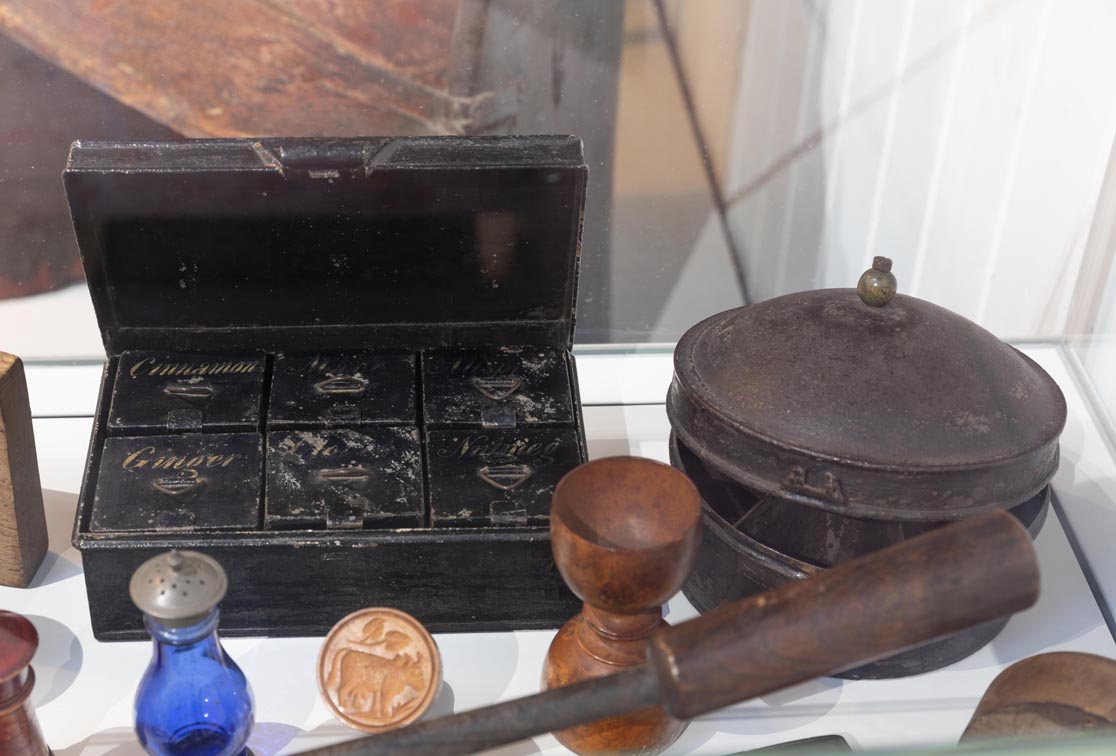
Spices and the Anjarakandy estate
Spice boxes were used in Victorian kitchens to add flavour or preserve meat. The box would store different spices like cinnamon, pepper, ginger, and nutmeg.
Many of the spices were imported to England from India. The East India Company established the Anjarakandy Cinnamon Estate in 1767. The plantation was managed by the overseer Murdoch Brown, who illegally expanded the estate into local inhabited land and kept a large number of slave workers on the farm. Due to the plantation’s success, the authorities failed to prevent him from committing these crimes towards the local people.
It was not until 1833, when slavery was abolished in England and parts of the British Empire, that the Anjarakandy plantation was investigated and found guilty of purchasing kidnapped children and women as slaves on his farm. The Anjarakandy case was significant. It highlighted issues concerning Englishmen in India owning slaves despite the abolition act. In the end, Mr Brown was not prosecuted for his crimes, demonstrating how slavery did not truly end but was hidden from the public eye.
MERL 51/689 & 53/184

Strikes and struggles of the Bombay textile industry
This is a cheesecloth cotton dress from the 1970s made in India. India was the world’s primary cotton textile producer and cotton was a significant export trade to Britain and other European countries through the East India Company.
The Bombay textile industry’s struggle and resistance are often left out mainstream discussions about the colonsation of India. Workers fought for the right to obtain bonuses and recognised trade union organisations, whilst battling wage cuts. Despite mill owners making a substantial profit, they continued to reduce their workers’ wages. Britain’s violence and oppression of textile workers was widespread, as colonial control over the police and military curtailed any industrial action.
The protests for improving workers’ rights continued after independence as mill owners continued to crush resistance. Finally, the textile workers organised mass strikes, leading to the Great Bombay Textile Strike in January 1982, headed by trade union leader Datta Samant. This consisted of 250,000 workers going on strike until their wages improved. Consequently, textile factories were shut down and the industry moved to Gujarat.
MERL 2009/5

Indian absence in catalogue displays
This display of catalogues, predominantly from the nineteenth century, shows advertising for the Suttons Seeds Company. Suttons had headquarters in Reading as well as a substantial presence in India. Companies like Suttons Seeds grew because of worldwide trade links forged by the British Empire, particularly expanding into the large markets of India and surrounding countries.
These catalogues – which are on display in our Wagon Walk gallery – do not feature any representation of the Indian Suttons or the seeds they produced. We recognise that this is an oversight on our part. Ideally, the display would accurately demonstrate the Indian element of Suttons, and how Indian workers contributed significantly to the company’s global success.
There is now a growing interest in showcasing the experiences of people in nations like India that were under British colonial rule. It is likely that exploring the archives of companies like Suttons is a way to learn more about them.
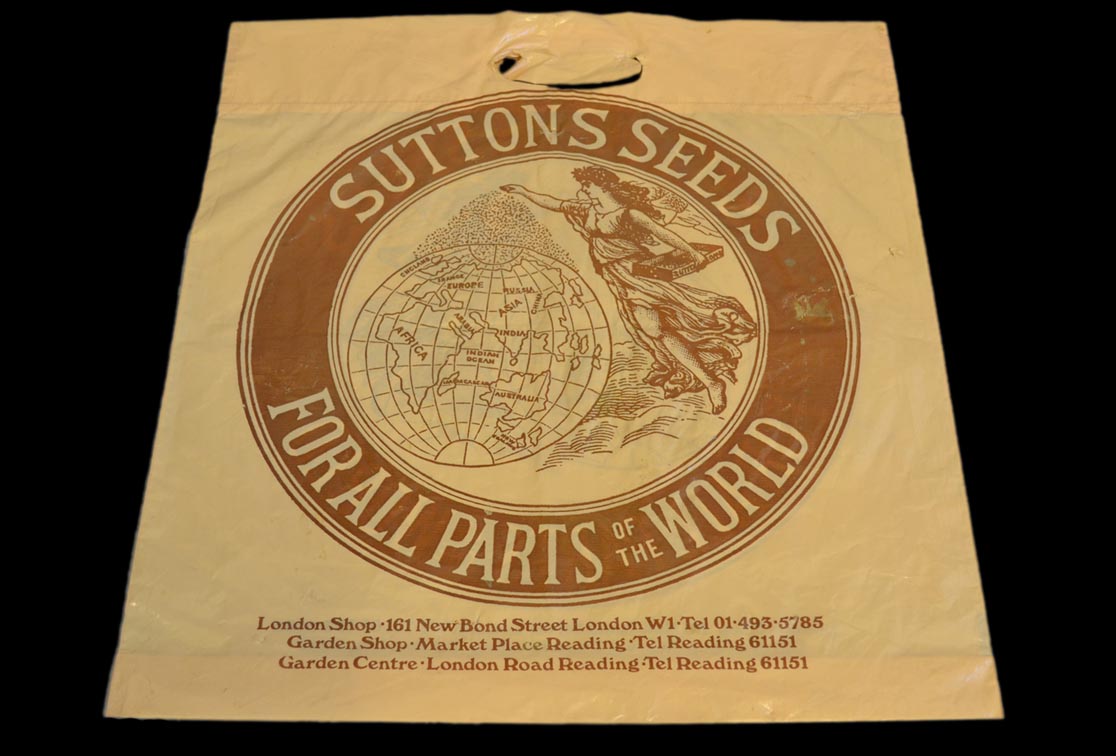
The colonial logo of Suttons Seeds
The addresses on this Suttons Seeds plastic bag suggest that it most likely dates to after 1962, when the company relocated from Reading where it had been based since 1804. On the bag is the same logo seen on other Suttons products, such as seed tins. The image of the woman probably represents the goddess of agriculture, Ceres. This hints at the motherly image of Sutton Seeds and their belief that they were providing help to other countries; Ceres is spreading the seeds over the world. It is worth noting that England, not the United Kingdom as a whole, is placed at the top of the world, suggesting a belief in England being on top and the sole source of colonial power in ruling other countries throughout the Empire.
It is interesting to note that this logo was still in use when Britain’s direct control of most colonies had officially receded, demonstrating a widely-held belief that British influence was still wielded within independent nations.
MERL 2010/118
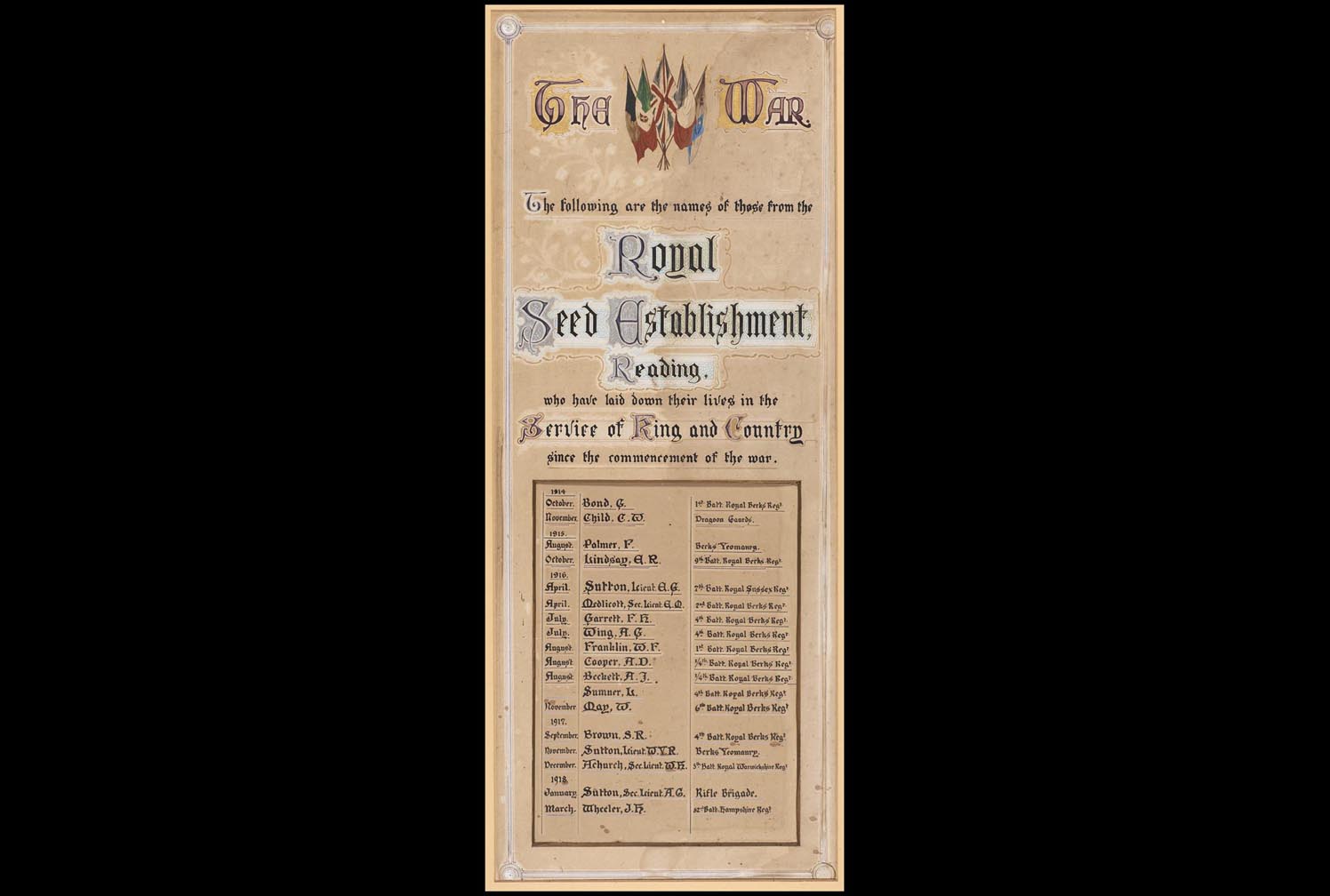
Suttons and rememberance
This war memorial, commissioned by Sutton Seeds, details a number of men who worked for the company who sadly lost their lives during the First World War. These men all worked for the Reading branch.
The onset of the First World War saw over 1.4 million Indian soldiers conscripted into the British Army, with around 53,000 of these men killed in action. The presence of Suttons in Calcutta and Ranchi suggests that Indian men employed by the company would have likely been killed in the war. Although we do not know of an Indian equivalent for this memorial, we cannot say for certain that one does not exist.
The Indian branch of Suttons Seeds is now an independent company named Suttind seeds, which distributes pollenated and hybrid seeds to commercial Indian farmers. It may be that such a memorial resides with them.
MERL 2007/19
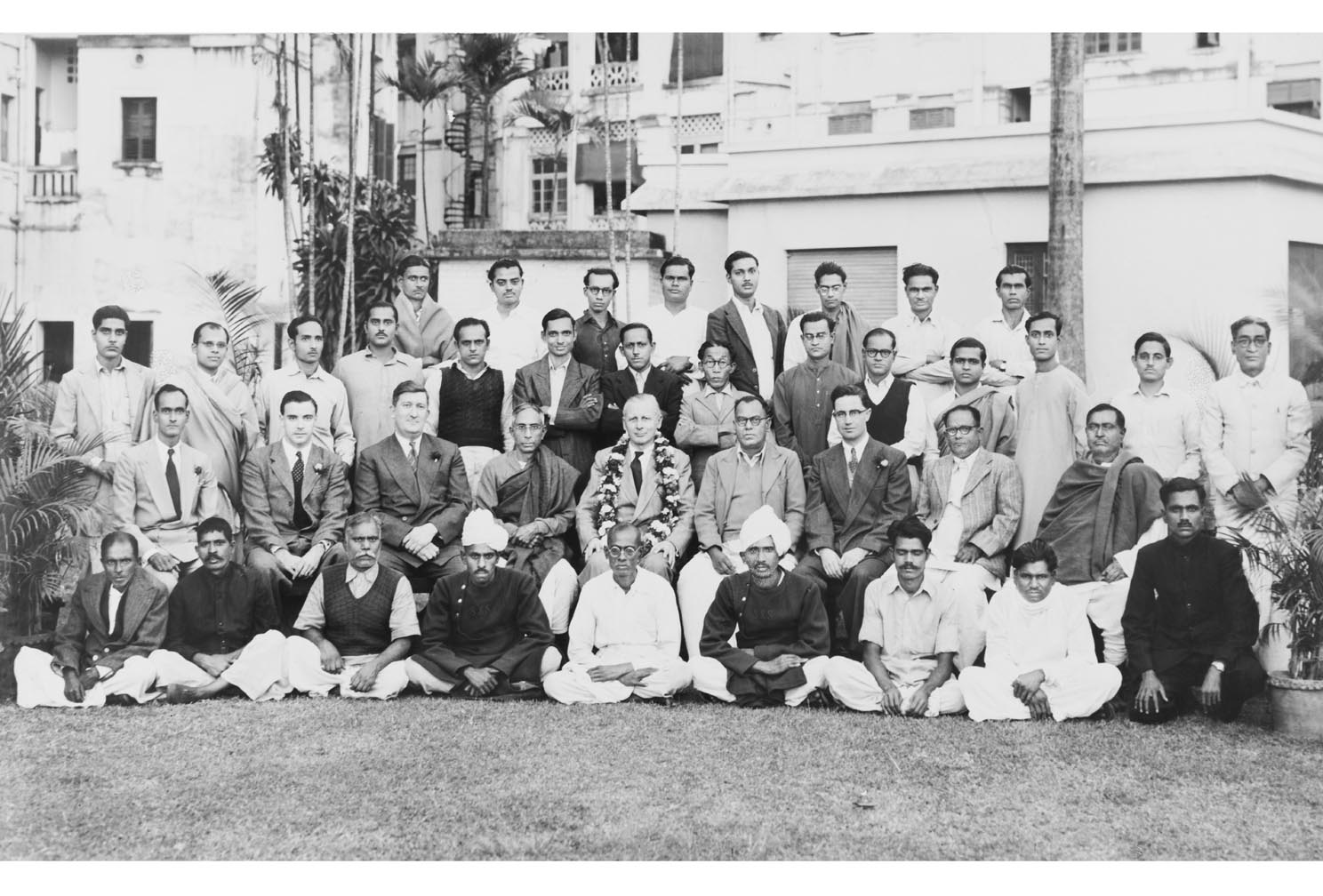
Lingering colonial power structures
This photo, taken in the mid-1950s, shows the staff at the Calcutta branch of Sutton Seeds, which remained under British management until 1972. The photo shows the branch’s British management alongside the Indian staff. The company did eventually separate from the British Sutton Seeds and became an Indian company in its own right. However, this was long after India declared independence in 1947, and shows how colonial structures remained for a significant length of time following independence. While the British management were named in the caption on the photograph, the Indian staff were not. This reveals the casual disregard British management seemed to have for local workers, even in this kind of record keeping.
TR SUT PH3/20
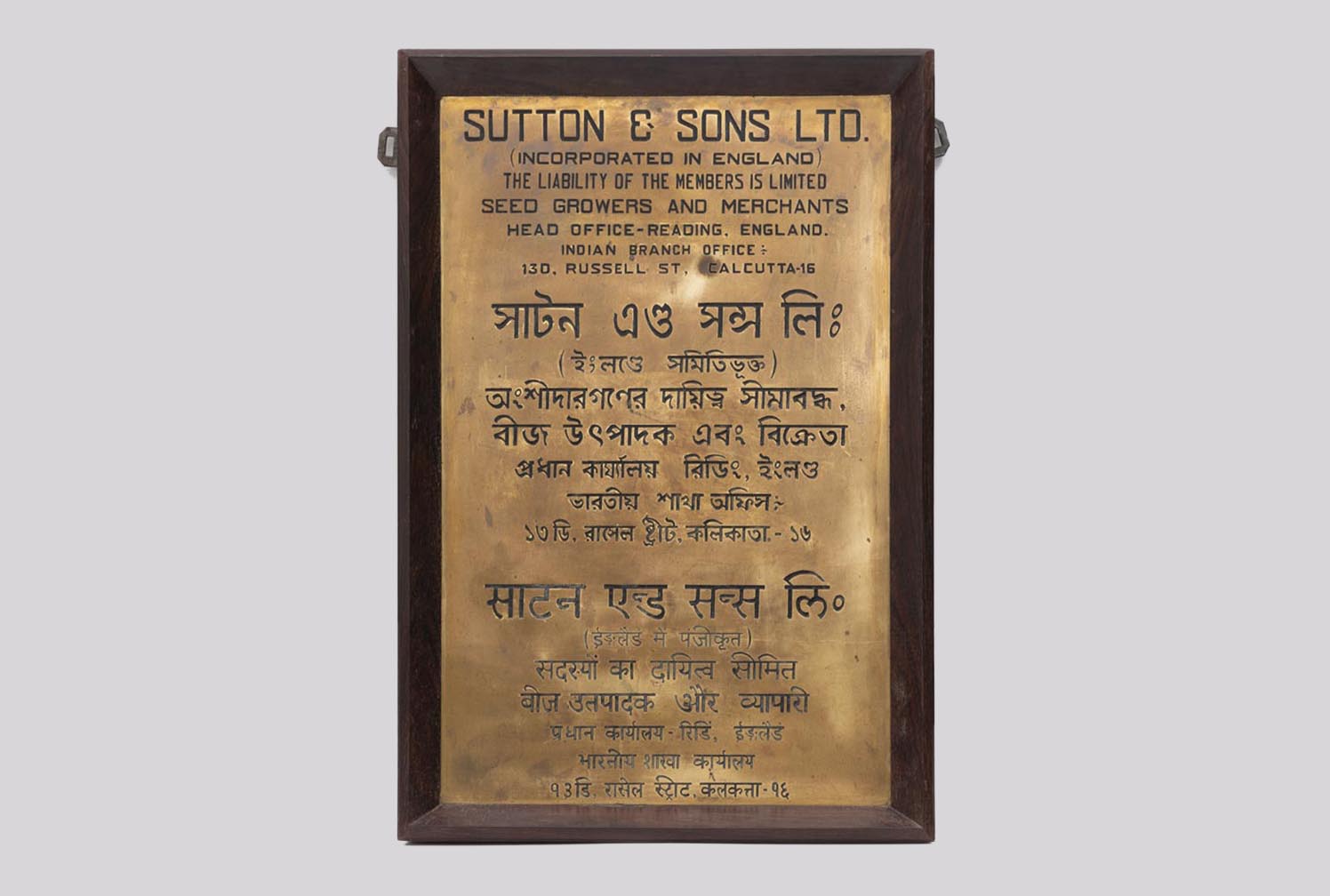
The power of language
This plaque originated from the Calcutta branch of Sutton Seeds. The plaque was acquired by John Hodges, the last British managing director of the branch. Though its text is written in English, Bengali and Hindi, it is notable that the English comes first, even though English would not have been the first language of the passers-by reading it. It serves as an important reminder of the colonial influence in India and how, even long after independence, this influence still remained.
MERL 2019/50
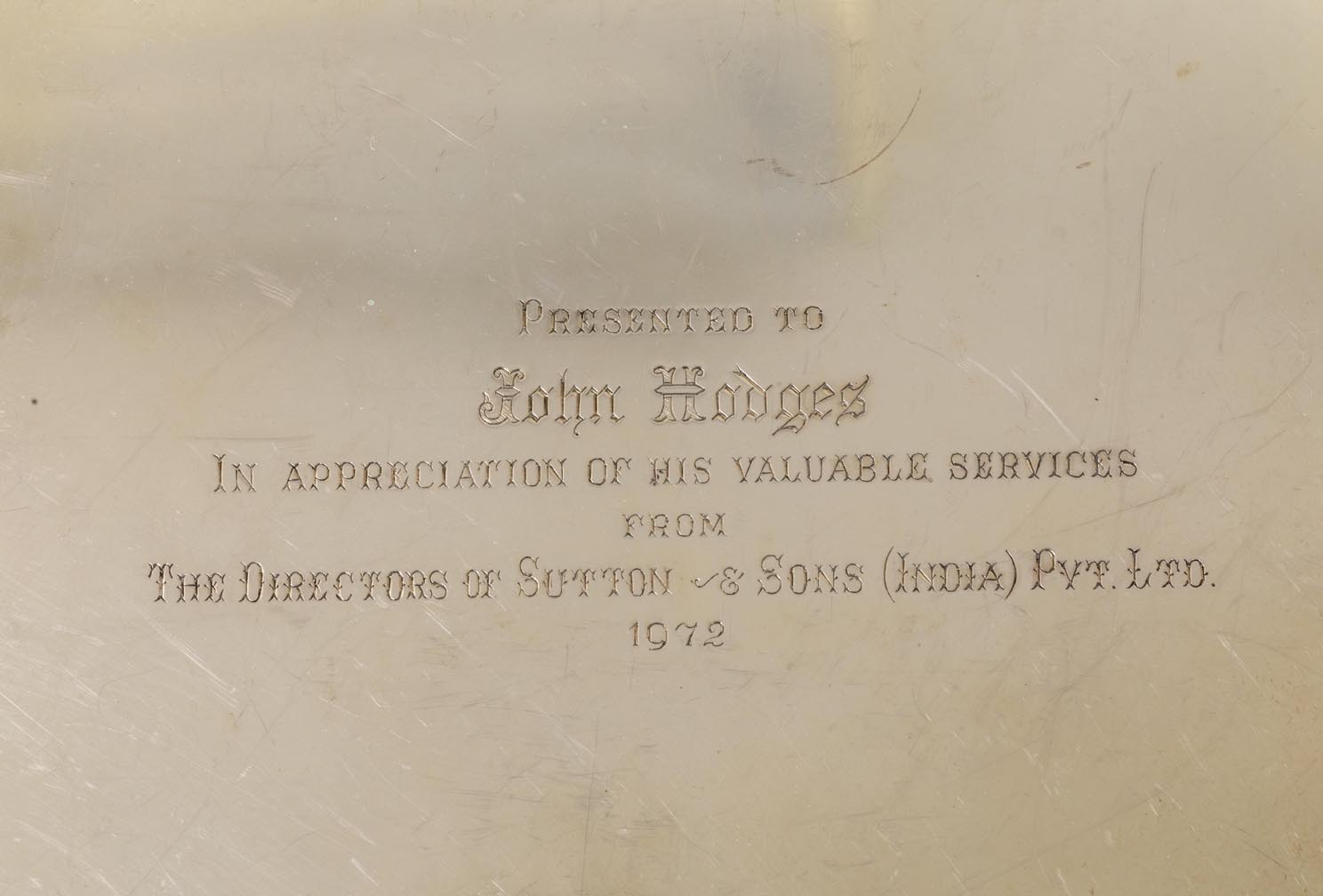
The benefits of local investment
This is the commemorative plate presented to John Hodges in 1972 upon his retirement, recording his services to the Calcutta branch of Sutton Seeds.
The Indian branches of Suttons became far more prosperous and wide-reaching in the last few years of Hodges’s management. This was due to Indian investment rather than British influence. Suresh and Naresh Kumar injected significant capital. Hodges recalled that “the investment from the Kumar family enabled the business to vastly increase its land holding so more seed was grown under its own supervision. Plant breeders were working on Hybrid varieties of various vegetables and flowers. Hermetically sealed packaging was introduced so stock could be kept safely for longer periods.”
It was at this point that the company transitioned into an Indian registered business.
MERL 2019/51
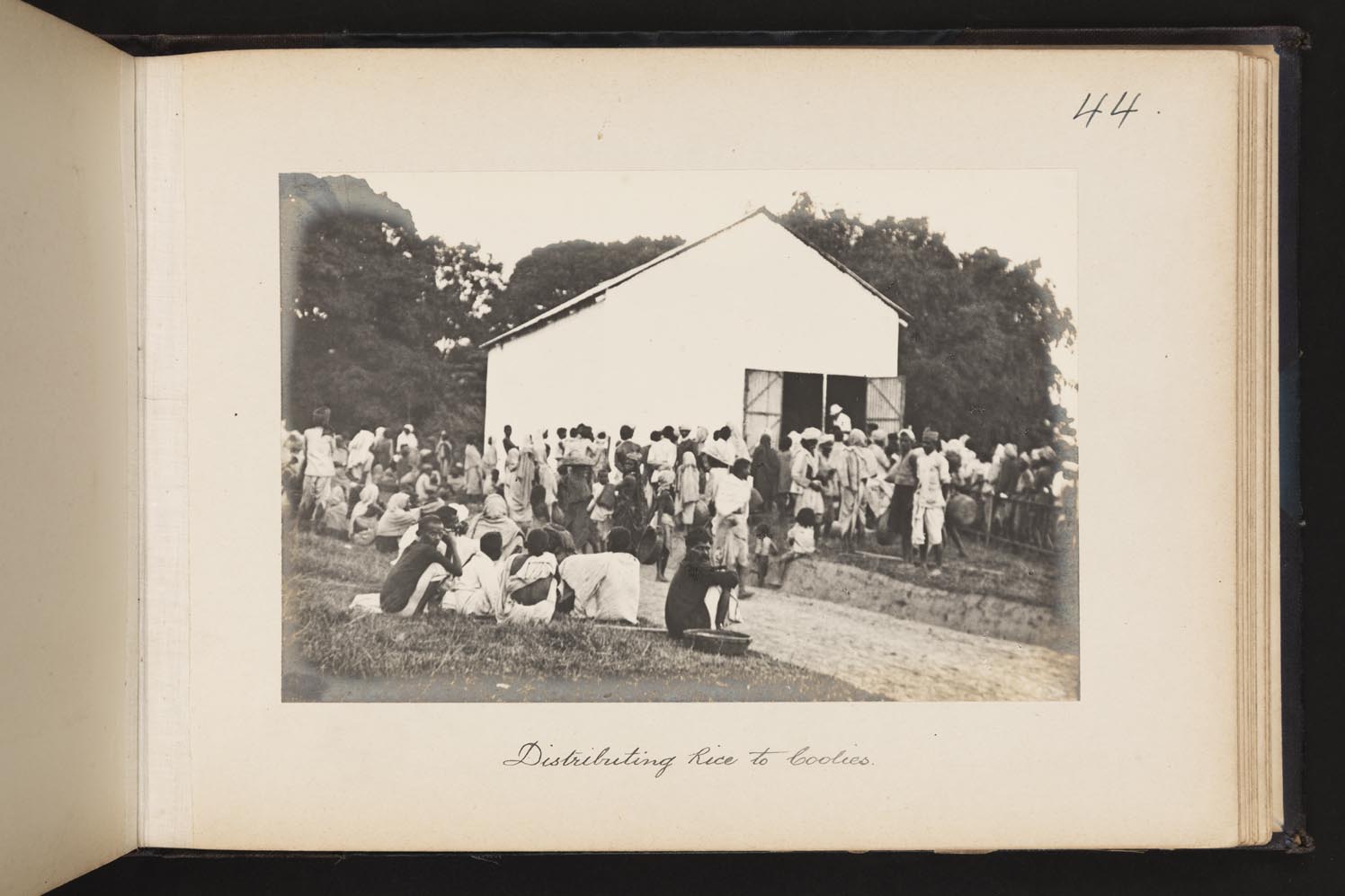
Racist attitudes towards workers
These photos are from an album compiled for Marshall, Sons & Company Ltd, who produced machinery for the tea industry. Founded in 1848, the company initially focused on agricultural technology, but gradually expanded into the development of ‘tea preparing machinery’ used extensively on this Calcutta site. The photos taken from the album provide a narrative of life on a Calcutta plantation for its workers and officials stationed there.
It is evident that the narrative offered by these photographs is explicitly one-sided. For example, in this image a large group of Indian workers wait to collect their meal. The original caption describes the scene as ‘Distributing rice to coolies’. This word was commonly used in a pejorative and racist way to refer to day workers or indentured labourers. The simplistic and hierarchical implications of the text suggest these workers were viewed by those who produced the album as a collective mass. However, the scene shows a diverse range of individuals.
TR MAR PH2/99/44
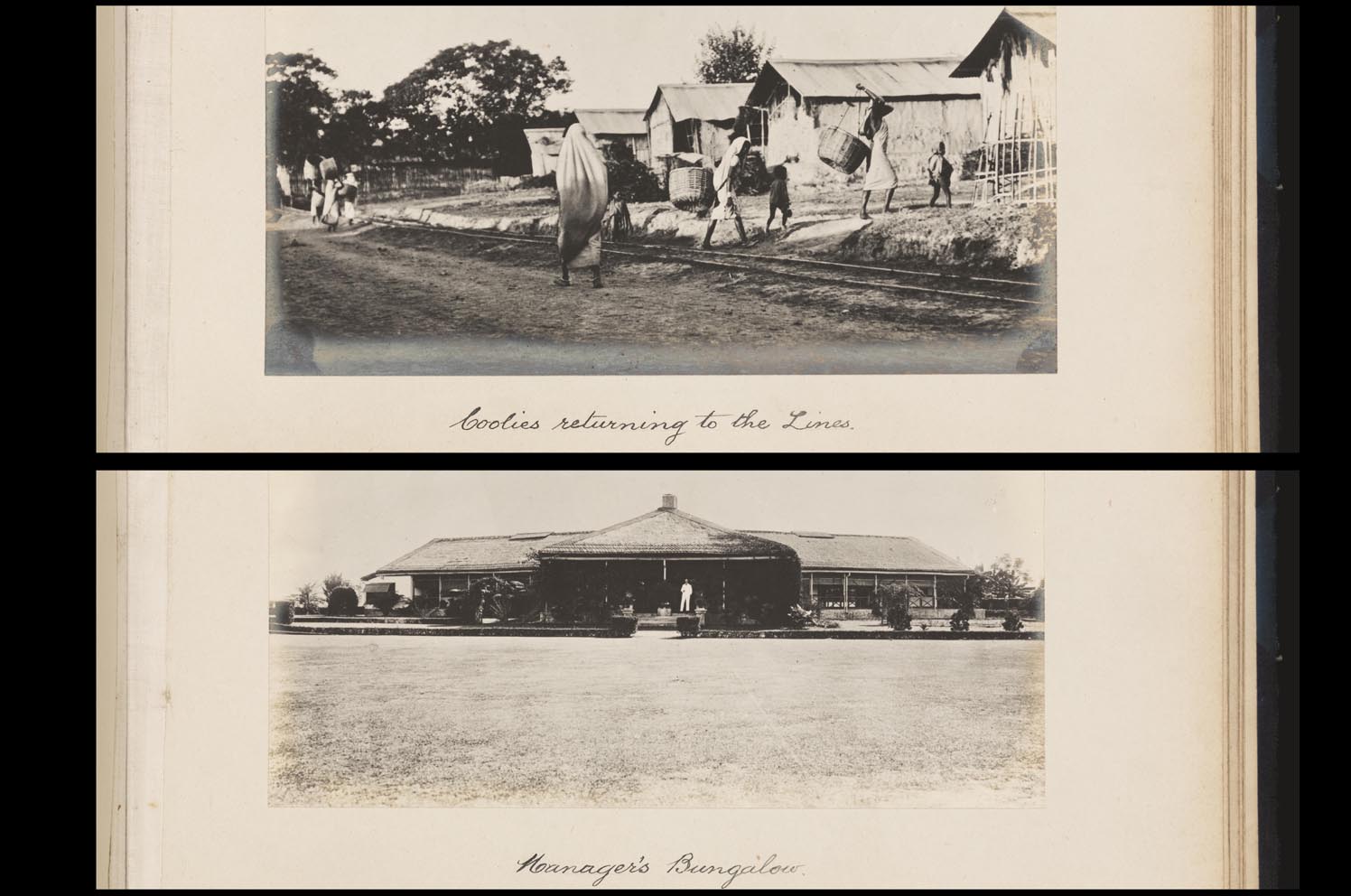
Differences in housing
A similar tone is also evidenced in these two photos, with the comparison of wealth and status between both the colonial workers and British officials providing another depiction of the hierarchal aspect of colonial plantations. Again, the labelling of colonial workers with the racist and derogatory term ‘coolies’ is highlighted in the top image, reducing the workers to a designation that suited those overseeing and directing their work.
This connotation of inferiority is also strengthened by the depiction of the workers and manager in the context of the plantation. Whilst the status of the British manager is solidified in the expansive bungalow granted to him, the shacks and train tracks provide a jarring contrast to the neatly manicured gardens of this managerial property. This seems to be deliberately emphasising the ‘appropriate’ areas to which colonial workers and British managers belonged within the plantation.
TR MAR PH2/99/45-46
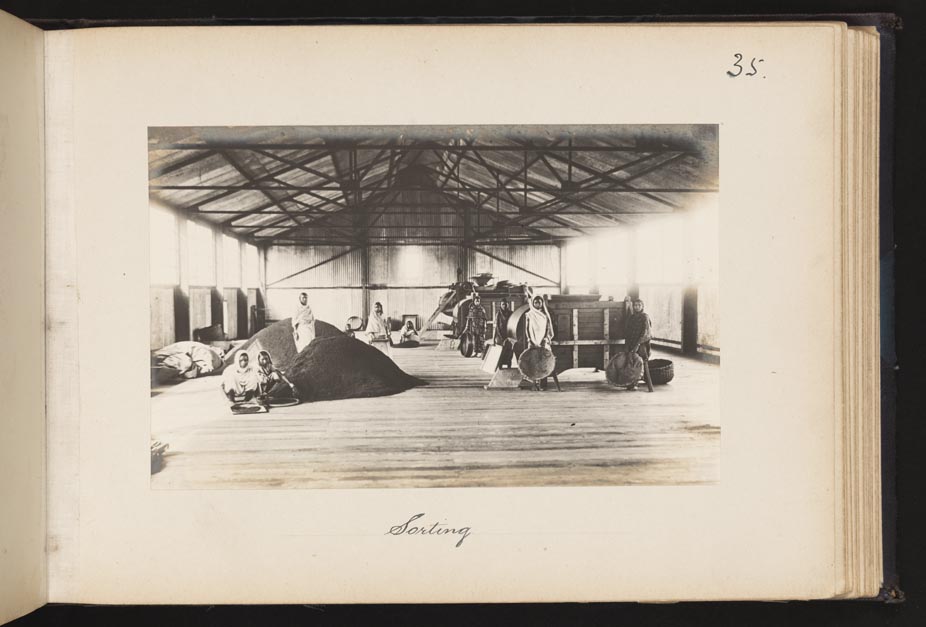
Conclusion
The extent of colonial influence and power throughout the course of the nineteenth and twentieth centuries is evident from these archival documents and objects from the MERL collections. Even after the declaration of Indian independence in 1947, colonial links still remained decades later. The voices of the colonised are overshadowed. Even within this exhibition which seeks to redress the balance, a lack of available primary sources from an Indian perspective remains a challenge.
This exhibition is only a first step in decolonising the MERL collections. In future, we must examine our own practices and interrogate our holdings ever more closely, whilst seeking to build new connections both locally and internationally.
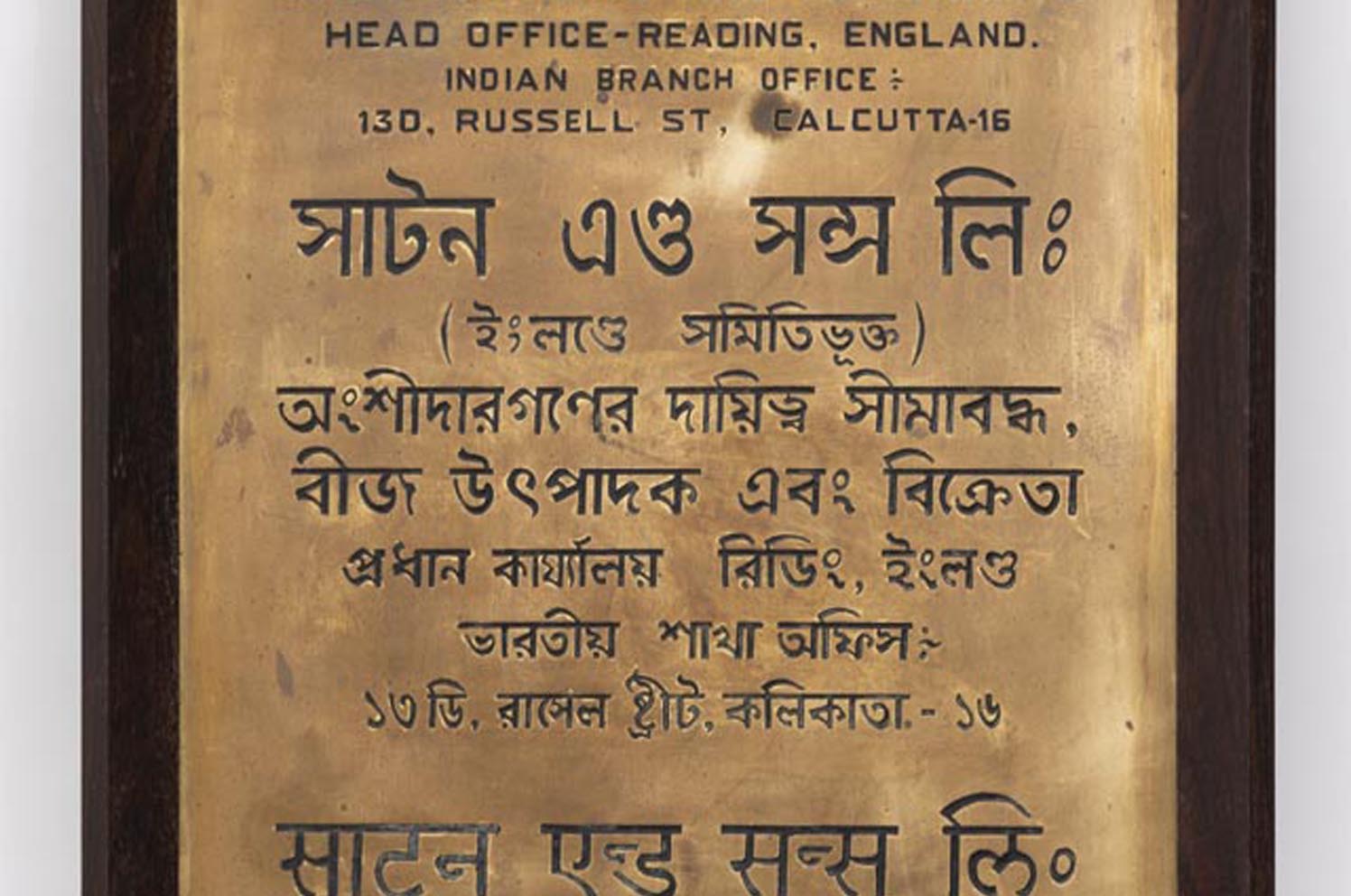
Acknowledgements and further resources
This exhibition was compiled in partnership with undergraduate History students from the University of Reading, including Eve Roberts, Fyza Tariq, Caroline Treagus, Charlotte Jones, George Cox, and others. We are also grateful to Tim Jerrome, Nic Minney and Dr Ollie Douglas for editorial and technical input.
In an earlier version of this exhibition the racially offensive term referred to in the captions for ‘Racist attitudes towards workers’ and ‘Differences in housing’ had been misread as the word ‘bodies’. We are grateful for external feedback in identifying this error, which led to alterations to the text and the addition of a suitable content warning.
The exhibition was produced as part of a public history placement and was developed with support from Professor Kate Williams and Dr Dafydd Townley from the Department of History. The students were tasked with using items from The MERL collection to research an aspect of British colonial history and to produce interpretation considerate of the perspectives of colonised peoples. Providing access to resources proved difficult due to the pandemic but the finished exhibition provides a successful overview, in spite of these challenging circumstances.
With thanks to all involved for their efforts.